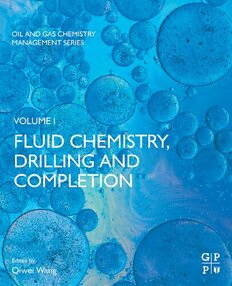
Fluid Chemistry, Drilling and Completion (Volume One) PDF
Preview Fluid Chemistry, Drilling and Completion (Volume One)
Fluid Chemistry, Drilling and Completion Oil and Gas Chemistry Management Series Fluid Chemistry, Drilling and Completion Volume 1 Edited by Qiwei Wang Saudi Aramco, Dhahran, Saudi Arabia GulfProfessionalPublishingisanimprintofElsevier 50HampshireStreet,5thFloor,Cambridge,MA02139,UnitedStates TheBoulevard,LangfordLane,Kidlington,Oxford,OX51GB,UnitedKingdom Copyright©2022ElsevierInc.Allrightsreserved. Nopartofthispublicationmaybereproducedortransmittedinanyformorbyanymeans,electronic ormechanical,includingphotocopying,recording,oranyinformationstorageandretrievalsystem, withoutpermissioninwritingfromthepublisher.Detailsonhowtoseekpermission,further informationaboutthePublisher’spermissionspoliciesandourarrangementswithorganizationssuch astheCopyrightClearanceCenterandtheCopyrightLicensingAgency,canbefoundatourwebsite: www.elsevier.com/permissions. Thisbookandtheindividualcontributionscontainedinitareprotectedundercopyrightbythe Publisher(otherthanasmaybenotedherein). Notices Knowledgeandbestpracticeinthisfieldareconstantlychanging.Asnewresearchandexperience broadenourunderstanding,changesinresearchmethods,professionalpractices,ormedical treatmentmaybecomenecessary. Practitionersandresearchersmustalwaysrelyontheirownexperienceandknowledgeinevaluating andusinganyinformation,methods,compounds,orexperimentsdescribedherein.Inusingsuch informationormethodstheyshouldbemindfuloftheirownsafetyandthesafetyofothers,including partiesforwhomtheyhaveaprofessionalresponsibility. Tothefullestextentofthelaw,neitherthePublishernortheauthors,contributors,oreditors,assume anyliabilityforanyinjuryand/ordamagetopersonsorpropertyasamatterofproductsliability, negligenceorotherwise,orfromanyuseoroperationofanymethods,products,instructions,orideas containedinthematerialherein. BritishLibraryCataloguing-in-PublicationData AcataloguerecordforthisbookisavailablefromtheBritishLibrary LibraryofCongressCataloging-in-PublicationData AcatalogrecordforthisbookisavailablefromtheLibraryofCongress ISBN:978-0-12-822721-3 ForInformationonallGulfProfessionalPublishingpublications visitourwebsiteathttps://www.elsevier.com/books-and-journals Publisher:CharlotteCockle SeniorAcquisitionEditor:KatieHammon EditorialProjectManager:AliceGrant ProductionProjectManager:ManjuThirumalaivasan CoverDesigner:MilesHitchen TypesetbyMPSLimited,Chennai,India Contents List ofcontributors................................................................................................xiii CHAPTER 1 Reservoir fluid geodynamics........................................1 Oliver C. Mullins,Li Chen, Soraya S. Betancourt, Vladislav Achourov, Hadrien Dumont, Jesus A. Can˜as, Julia C. Forsytheand Andrew E. Pomerantz 1.1 Introduction....................................................................................1 1.2 Reservoir fluid geodynamics.........................................................2 1.2.1 Asphaltene science..............................................................6 1.2.2 Oraintelligent wirelineformationtesting platform and DFA.............................................................11 1.3 RFG oilfield case studies.............................................................14 1.3.1 RFG applied toa light oil reservoir.................................14 1.3.2 RFG applied toa black oil field.......................................21 1.4 RFG workflow..............................................................................28 1.5 Conclusions..................................................................................30 Nomenclature...............................................................................31 References....................................................................................32 CHAPTER 2 Sampling petroleum fluids.........................................41 Curtis Hays Whitson, SisselØ.Martinsen and Bilal Younus 2.1 Introduction..................................................................................42 2.1.1 From upstreamtodownstream.........................................43 2.1.2 Sampling types—theshort list..........................................44 2.1.3 Definingreservoirtype.....................................................44 2.1.4 Fluidinitialization.............................................................45 2.1.5 In situ-representativeversus reservoir representativesamples......................................................48 2.1.6 Developing PVT models...................................................49 2.2 Samplingprocedures and measurements.....................................52 2.2.1 Sampling types..................................................................52 2.2.2 How do we use samples?..................................................65 2.2.3 Sampling standards...........................................................66 2.2.4 Compositionalanalyses....................................................67 2.3 Samplingstrategies......................................................................68 2.3.1 Balancing wish lists and costs..........................................68 2.3.2 Discovery wells.................................................................69 2.3.3 Delineation wells..............................................................70 v vi Contents 2.3.4 Productionwells................................................................70 2.3.5 EOR wells.........................................................................71 2.3.6 Problem wells....................................................................71 2.3.7 Fluid system considerations..............................................71 2.4 Special issues in sampling...........................................................74 2.4.1 Sample storage..................................................................74 2.4.2 Separatorsampling............................................................75 2.4.3 Using contaminated PVT samples....................................77 2.4.4 Wax, asphaltenes,scale, and hydrates..............................81 2.4.5 Mudgas sampling.............................................................83 2.4.6 Tight unconventionals.......................................................83 2.5 Conclusions..................................................................................87 Nomenclature...............................................................................89 References....................................................................................91 CHAPTER 3 Water chemistry..........................................................95 WeiWang and WeiWei 3.1 Introduction..................................................................................95 3.2 Types ofwater samples................................................................96 3.3 Water sampling and analysis.......................................................97 3.4 Water data evaluation..................................................................99 3.5 Water chemistrydata interpretationandreconciliation............100 3.6 Factors that impact/change water chemistry.............................101 3.7 Field case examples ofwater chemistry application.................105 3.7.1 Original oil inplace(OOIP)estimate............................106 3.7.2 Water sourceidentification.............................................106 3.7.3 Management ofscale,corrosion, andother water-related production problems.................................107 3.7.4 Producedwater chemistry surveillance and applicationsinshaleand tight plays...............................109 3.8 Final remarks..............................................................................110 Nomenclature.............................................................................111 References..................................................................................111 CHAPTER 4 Drilling fluids............................................................115 Jay P. Deville 4.1 Introduction................................................................................115 4.2 Drillingfluidfunctions...............................................................116 4.2.1 Formationpressure management and wellbore stability(cid:1)fluid density....................................................116 4.2.2 Hole cleaning—fluid rheological properties..................119 Contents vii 4.2.3 Seal permeable formations—fluid loss control and bridging....................................................................122 4.2.4 Reduce friction—fluid lubricity.....................................123 4.2.5 Other functions................................................................124 4.3 Drilling fluid types.....................................................................124 4.4 Aqueous-based fluids.................................................................125 4.4.1 Water-basedfluidadditives............................................125 4.4.2 Water-basedfluids types.................................................141 4.5 Nonaqueous fluids......................................................................143 4.5.1 Nonaqueous fluids additives...........................................144 4.5.2 Nonaqueous fluidtypes..................................................156 4.6 Reservoir drilling fluids.............................................................159 4.6.1 Reservoir drilling fluid additives....................................161 4.7 Conclusion..................................................................................166 Nomenclature.............................................................................167 References..................................................................................168 CHAPTER 5 Cementing additives.................................................187 Arnaud Cadix and SimonJames 5.1 Introduction................................................................................187 5.2 Cementbasics.............................................................................188 5.2.1 Chemical notation...........................................................188 5.2.2 Portland cement chemistry.............................................189 5.2.3 Hydration of Portlandcement.........................................190 5.2.4 Interparticle interactions.................................................196 5.2.5 Application towell cements...........................................196 5.3 Slurry formulation......................................................................197 5.3.1 Temperature....................................................................197 5.3.2 Slurrydensity..................................................................198 5.3.3 Placement time................................................................203 5.3.4 Rheologicalproperties....................................................216 5.3.5 Fluidloss control............................................................225 5.3.6 Gas migration control.....................................................234 5.3.7 Other additives................................................................237 5.4 Summary.....................................................................................241 5.4.1 Polymers incement formulations...................................241 5.4.2 Formulation approach.....................................................244 Nomenclature.............................................................................244 Conversion Factors....................................................................245 Acknowledgments.....................................................................245 References..................................................................................246 viii Contents CHAPTER 6 Completion and workover fluids ..............................255 Balakrishnan Panamarathupalayam and Cedric Manzolelua 6.1 Introduction................................................................................256 6.2 Types ofcompletion brines........................................................256 6.2.1 Halide brines (inorganic salts)........................................257 6.2.2 Formatebrines (organicsalts)........................................258 6.2.3 Potassiumcarbonatebrine..............................................258 6.3 Considerationsfor completion brine selection..........................259 6.3.1 Density requirement........................................................259 6.3.2 Crystallization temperature.............................................260 6.3.3 Hydrate inhibition...........................................................261 6.3.4 Compatibility with formation fluids...............................263 6.3.5 Compatibility with reservoir matrix...............................264 6.3.6 Corrosion ofcompletion hardware.................................264 6.3.7 Environmental and safety...............................................265 6.3.8 Cost..................................................................................267 6.4 Completion brineproperties measurement................................267 6.4.1 Density............................................................................267 6.4.2 Iron content.....................................................................268 6.4.3 Turbidity..........................................................................268 6.4.4 Total suspended solids....................................................268 6.5 Completion brineadditives........................................................269 6.5.1 Corrosion inhibitors........................................................269 6.5.2 Lubricants........................................................................272 6.5.3 Viscosifierand fluid loss control....................................274 6.6 Conclusion..................................................................................277 Nomenclature.............................................................................278 References..................................................................................278 CHAPTER 7 Packer fluids.............................................................283 RosaSwartwout and Arthur Hale 7.1 Introduction................................................................................283 7.2 Types ofpackerfluids................................................................284 7.3 Solids-free brines........................................................................284 7.4 Packer fluidproperties...............................................................287 7.4.1 Density............................................................................287 7.4.2 Crystallization temperature.............................................288 7.4.3 Fluid clarity.....................................................................288 7.4.4 Corrosion andcorrosion inhibition.................................289 7.4.5 Fluid compatibility..........................................................291 Contents ix 7.5 Displacement..............................................................................291 7.6 Safety..........................................................................................292 7.7 Summary.....................................................................................292 Nomenclature.............................................................................293 References..................................................................................293 CHAPTER 8 Carbonate matrix stimulation...................................297 Murtaza Ziauddin 8.1 Introduction................................................................................297 8.2 Candidate selection....................................................................299 8.3 Chemicaland physical processes incarbonate acidizing..........302 8.3.1 Reactions of carbonate rocks with strong inorganic acids................................................................302 8.3.2 Reactions of carbonate rocks with weak organic acidsand chelants...........................................................305 8.3.3 Carbonate dissolution patterns: influence of transportand reaction......................................................308 8.3.4 Wormhole growth models..............................................313 8.3.5 Influence ofmineralogy and porosity type....................314 8.4 Stimulationfluid engineering....................................................319 8.4.1 Single-phase retarders for HCl(cid:1)carbonatereaction......319 8.4.2 Organic acids andchelants.............................................320 8.4.3 Polymer and viscoelastic surfactant gelled acids...........322 8.4.4 Emulsified acids..............................................................324 8.4.5 Foamed acids...................................................................326 8.5 Stimulationtreatmentdesign.....................................................326 8.5.1 Designchallenges...........................................................328 8.5.2 Designoptimization........................................................330 8.6 Summary.....................................................................................332 Nomenclature.............................................................................333 References..................................................................................333 CHAPTER 9 Sandstone matrix stimulation...................................341 Mohamed Mahmoud and Ibrahim Gomaa 9.1 Introduction................................................................................342 9.2 Formationdamage mechanisms insandstone reservoirs..........344 9.2.1 Clay swelling...................................................................344 9.2.2 Fines migration...............................................................345 9.2.3 Inorganic scale deposition..............................................347 9.2.4 Organic scale deposition.................................................348 9.2.5 Damage during drilling andcompletion.........................348 9.2.6 Damage during reservoirstimulation.............................349 x Contents 9.3 Acid types...................................................................................350 9.3.1 Hydrofluoric acid and mud acid.....................................350 9.3.2 HCl acid..........................................................................354 9.3.3 Retarded acids.................................................................355 9.3.4 Chelating agents..............................................................356 9.3.5 Organic acid mixtures.....................................................358 9.3.6 New developments..........................................................359 9.4 Acid additives.............................................................................360 9.4.1 Corrosion inhibitor..........................................................360 9.4.2 Surfactants.......................................................................361 9.4.3 Clay stabilizers................................................................361 9.4.4 Iron control agents..........................................................361 9.4.5 Liquefiedgases and foaming agents..............................363 9.5 Acid diversion and placement....................................................363 9.5.1 Mechanical means...........................................................363 9.5.2 Chemicalmeans..............................................................365 9.6 Laboratory testing techniques and equipment...........................366 9.6.1 Rock solubility tests........................................................366 9.6.2 Core flooding experiments..............................................367 9.6.3 Petrographic tests............................................................368 9.6.4 Zeta potential measurement/surfacecharge...................369 9.7 Treatment design........................................................................369 9.7.1 Preflushstage..................................................................369 9.7.2 Main flush stage..............................................................370 9.7.3 Postflushstage.................................................................371 9.8 Sandstoneacidizing models.......................................................371 9.8.1 Conventional permeability models.................................371 9.8.2 Permeability model with mineralogy effect...................372 9.8.3 Precipitation models........................................................376 9.9 Field treatments..........................................................................376 9.10 Summary.....................................................................................377 Nomenclature.............................................................................379 References..................................................................................379 CHAPTER 10 Acid fracturing stimulation.......................................387 FrankF. Chang 10.1 Petroleumengineering and geological aspects..........................387 10.2 Acid fracturing chemistry..........................................................389 10.3 Reactionkinetics........................................................................393 10.4 Systemofchemical additives inacid........................................400 10.4.1 Corrosion inhibitors......................................................401
